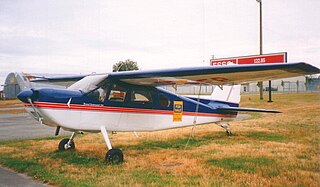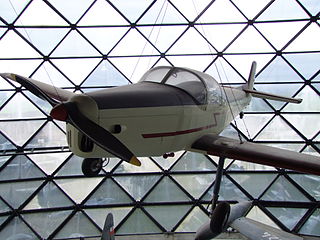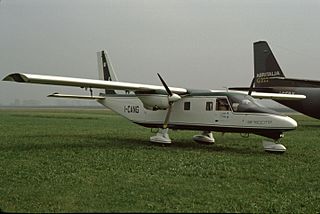The Aeronca Model 9 Arrow was a low-wing all-metal cabin monoplane with retractable landing gear. It was marketed to returning pilots from World War II and unveiled in 1947 but never went into production.

The Cessna Model 411 is an American twin-engined, propeller-driven light aircraft built by Cessna Aircraft. It was that company's largest business aircraft to enter production when it first flew in 1962.
The Anderson EA-1 Kingfisher is a US two-seat amphibious aircraft designed and marketed for homebuilding. It was the work of Earl William Anderson, a Pan Am airline captain, who flew the prototype on 24 April 1969. By 1978, 200 sets of kits for the plane had been sold, and 100 Kingfishers were reported to be under construction. The aircraft is a shoulder-wing monoplane with a flying boat hull and outrigger pontoons. On land, it uses retractable tailwheel undercarriage. The single engine with a tractor propeller is mounted in a nacelle above the wing. Some builders utilize the wings from a Piper Cub rather than making their own.

The Found Centennial 100 is a Canadian six-seat cabin monoplane produced by Found Brothers Aviation.

The LIBIS KB-6 Matajur was a 1950s Slovenian two-seat light monoplane designed and produced by LIBIS aircraft during Yugoslavian period.
The Civil Aviation Department Revathi was a light utility aircraft designed in India principally for use by that country's flying clubs.
The Piper PA-6 Sky Sedan was a 1940s American four-seat light aircraft designed and built in prototype form by Piper Aircraft at its Lock Haven, Pennsylvania, factory.

The Robin HR100 is a French four-seat light monoplane, designed by Chris Heintz and built by Avions Pierre Robin as metal-winged version of the Robin DR253 Regent.
The Duruble Edelweiss is a light utility aircraft designed in France in the early 1960s and marketed for homebuilding. It is a low-wing cantilever monoplane with retractable tricycle undercarriage and all-metal construction. The aircraft was designed for a load factor of 9. Two- and four-seat versions were designed. The aircraft's creator, Roland Duruble flew the first example, a two-seater designated RD-02 in 1962, and in 1970 began to market plans for a stretched version with a rear bench seat as the RD-03. Over the next 15 years, 56 sets of plans had been sold, and at least nine Edelweisses finished and flown. In the 1980s, Duruble marketed an updated version of his original two-seater as the RD-02A, and sold around seven sets of plans, with at least one aircraft flying by 1985.

The PZL-102 Kos (blackbird) is a Polish two-seat touring and training monoplane designed and built by PZL.

The SIAI-Marchetti S.210 was a 1970s Italian twin-engined cabin-monoplane designed and built by SIAI-Marchetti as a development of the single-engined SIAI-Marchetti S.205.

The Wing D-1 Derringer is an American light twin-engined two-seat monoplane tourer designed by John Thorp and developed by the Hi-Shear Corporation and built by the Wing Aircraft Company.
The Frederick-Ames EOS/SFA was a single-seat sports aircraft designed in the United States in the 1970s with the intention of marketing it for homebuilding. It was a highly streamlined low-wing cantilever monoplane with swept flying surfaces and retractable tricycle undercarriage. Its construction was of metal throughout.

The Vulcanair SF.600 Canguro was a feederliner developed in Italy in the late 1970s. Despite a number of attempts to put the aircraft into series production, only a small number were ever built. The Canguro was a high-wing cantilever monoplane of conventional configuration with a fuselage of rectangular cross-section and a high-set tail. The tricycle undercarriage was not retractable, and its main units were carried on sponsons on the fuselage sides. SIAI Marchetti provided funding towards the construction of the prototype, and constructed this aircraft at the former Aviamilano plant. After flight testing proved positive, the type was put on sale, but failed to attract buyers in any number, even when the original piston engines were exchanged for turboprops and retractable undercarriage was offered as an option.

The Italair F.20 Pegaso was a twin-engine utility aircraft designed by Stelio Frati and built in Italy in 1971.

The PZL M-17 "Duduś Kudłacz" was a Polish twin-boom pusher general aviation and trainer aircraft of 1977, which remained a prototype.
The Hispano HS-42 and its derivative, the HA-43, were advanced military trainer aircraft produced in Spain in the 1940s. The basic design was that of a conventional, low-wing, cantilever monoplane with seating for the pilot and instructor in tandem. The HS-42 had fixed, tailwheel undercarriage with spatted mainwheels, while the HA-43 had retractable main units. Produced on the assembly line that had been used to build Fokker D.XXI fighters, the HS-42 shared some components with this aircraft.
The Partenavia P.55 Tornado is a 1950s Italian high-performance competition and touring monoplane built by Partenavia. The Tornado was a small mid-wing cantilever monoplane with a retractable tricycle landing gear. The aircraft was powered by a nose-mounted Lycoming O-320 piston engine.

The Wassmer WA-40 Super 4 Sancy is a French single-engined light aircraft of the 1960s and 70s. A single-engined low-winged monoplane with retractable nosewheel undercarriage, variants include the more powerful WA 4/21 Prestige and the WA-41 Baladou with a fixed undercarriage.
The Civil Aviation Department MG-1 was a one-off Indian motor glider, seating two side by side and first flown in 1983.











